San Francisco, CA
San Francisco: Goodbye, El Dorado: Fear And Poverty In San Francisco – Times of India

Strong words, from Elon Musk’s tweets. What’s the big deal, readers might ask. The man is a compulsive tweeter and an equally compulsive provoker. The big deal is that Musk’s musings on apocalypse and Hollywood horror tropes were aimed at an American city that for most of the world is 21st century’s El Dorado – San Francisco, Twitter (now X) and global tech’s HQ. SF, as it is inevitably acronymised in America, where acronymising is a reflex cultural habit, conjures up visions of cutting-edge computing, dressed-down ultra-rich tech bosses, hip geeks, eye-wateringly expensive restaurants with superfoods on their menu, and, for those with a political-sociological bent of mind, a supercool liberal culture, an inheritance of the times the city was the global epicentre of flower power. Now, SF is the poster city of urban decline in America.
US media is awash with accounts of SF’s horrors – an epidemic of street crime, open-air drug use, zombie-like addicts looking for their next fix, empty, ghostly office towers and stores, and a flood of homeless people. So, Musk, this time, was on the ball. Thousands of San Franciscans, on the other hand, are on fentanyl, a synthetic drug that gives a short-lived, powerful high.
A Financial Times feature on SF quotes a resident, “Flower power kids came here in the ’70s to rebel against their parents… Now, kids come here to do fentanyl.” When any city gets walloped as hard as SF has been with a drug-crime-homelessness problem, four things happen – the rich leave, the white collars try to stay away from the many trouble spots, stores and offices catering to these well-off classes lose business, and the ranks of the desperate poor swell. Jeff Bezos’s Whole Foods, which sells lyrically labelled, pricey grub to the wealthy, shut its SF store. American luxury retail chain Nordstrom also left the city.
Per the FT feature, 2,500 businesses have left downtown SF since March 2020. The March 2020 cut-off is significant – that’s when Covid lockdowns hit most of the world’s cities, including SF. But, as American commentators have noted, other cities recovered and went past pre-pandemic economic activity levels. SF hasn’t. Perhaps, being the HQ of tech hit SF hard.
Pandemic-time remote tech work sort of got institutionalised and office spaces remained vacant even when the worst of Covid was over. Plus, tech companies ruthlessly downsized workforce as the pandemic-induced global demand boom for B2C and B2B tech services subsided.
That hollowed out some of SF’s better-paid working population. But Sars-CoV-2 didn’t spawn the walking dead in SF, or the relentless march of petty, sometimes violent, crime, or the police’s apparent helplessness to do anything about it, or, as visitors to the city have noted, widespread and visible destitution. The whys of this urban dystopia are hotly contested by America’s chattering classes. Right-wingers, like Musk or another tech mogul, Peter Thiel, blame SF’s ‘woolly’, ‘wrong-headed’ liberal politics. Some rich liberals and even bits of America’s liberal media agree.
Other liberals point to structural inequalities like the white-black income divide, the ‘heartless’ meritocracy of tech, and the wider American problem of an economic system ‘designed’ to create deep pockets of poverty. The last has been explored in depth by two American academics, Mark Robert Rank (The Poverty Paradox) and Mathew Desmond (Poverty, By America). Their blame list includes: Government tax giveaways that mostly favour the better-off Big companies subcontracting work to staffing agencies that offer low pay and no benefits to workers.
Relatively stagnating wages, high housing costs. And, overarchingly, a system where well-paid employees and the rich need booming stock markets to increase their wealth and stock markets need companies to cut down on costs This means tamping down wages and/or farming out work to modern-day sweatshops. Those inclined to locate SF’s decay in these structuralist analyses will note that a recent study said 34% of families in California – America’s richest state and the world’s fifth largest economy – don’t earn enough to cover “basic living costs”.
By such metrics, SF, a Californian city, is more of a rule than an exception. There’s another take: that SF will recover because it’s always been a city where good times and bad times follow each other, right from the time of the mid-19th century California Gold Rush. Maybe. But as of now, SF is a stark and sobering demonstration that the first world, indeed the richest country of the first and the entire world, is no stranger to despairing poverty. We began by quoting Musk. Let’s end by quoting JFK: “If a free society cannot help the many who are poor, it cannot save the few who are rich.”

San Francisco, CA
Warriors dance squad presents special Christmas show

Watch CBS News
Be the first to know
Get browser notifications for breaking news, live events, and exclusive reporting.
San Francisco, CA
3 California beaches closed as collapsed pier debris washes ashore

As detritus from the badly damaged Santa Cruz pier washes ashore, California State Parks officials are keeping three beaches closed. “Because of the amount of debris washing up onto the local beaches from the collapsing Santa Cruz municipal wharf,” Twin Lakes State Beach, Seabright State Beach and San Lorenzo Point will be closed until Dec. 30 at 6 a.m., Santa Cruz State Beaches said.
Seacliff State Beach and Rio Del Mar State Beach both reopened on Christmas morning, though visitors should take care: A high-surf warning is in effect along the coast from Thursday morning until Sunday afternoon. The National Weather Service is advising people to stay off piers and jetties.
About 150 feet of the Santa Cruz pier and an entire building housing a restroom broke off into the ocean on Monday amid battering waves. Three people working on the pier plunged into the water, where two needed rescue and a third was able to rescue themselves. Since then, pieces of the wharf have been washing onto local beaches. There is no estimated reopening for the wharf itself. Waves also pulled support piling from the Cayucos Pier about 160 miles south down the Central Coast. The end of the pier was already closed as it incurred damage during stormy conditions in February.
“Please be cautious when near the ocean, as debris from damage north of Capitola is making its way down the coastline,” the Capitola Police Department said. “Several large pilings from the Santa Cruz wharf have found their way to our shores, creating an extreme hazard. Please use caution if you are in the area.”
San Francisco, CA
San Francisco celebrates Christmas, first night of Hanukkah
-
/cdn.vox-cdn.com/uploads/chorus_asset/file/24924653/236780_Google_AntiTrust_Trial_Custom_Art_CVirginia__0003_1.png)
/cdn.vox-cdn.com/uploads/chorus_asset/file/24924653/236780_Google_AntiTrust_Trial_Custom_Art_CVirginia__0003_1.png) Technology6 days ago
Technology6 days agoGoogle’s counteroffer to the government trying to break it up is unbundling Android apps
-

 News7 days ago
News7 days agoNovo Nordisk shares tumble as weight-loss drug trial data disappoints
-

 Politics7 days ago
Politics7 days agoIllegal immigrant sexually abused child in the U.S. after being removed from the country five times
-

 Entertainment1 week ago
Entertainment1 week ago'It's a little holiday gift': Inside the Weeknd's free Santa Monica show for his biggest fans
-

 Lifestyle1 week ago
Lifestyle1 week agoThink you can't dance? Get up and try these tips in our comic. We dare you!
-
/cdn.vox-cdn.com/uploads/chorus_asset/file/25672934/Metaphor_Key_Art_Horizontal.png)
/cdn.vox-cdn.com/uploads/chorus_asset/file/25672934/Metaphor_Key_Art_Horizontal.png) Technology2 days ago
Technology2 days agoThere’s a reason Metaphor: ReFantanzio’s battle music sounds as cool as it does
-

 Technology1 week ago
Technology1 week agoFox News AI Newsletter: OpenAI responds to Elon Musk's lawsuit
-

 News3 days ago
News3 days agoFrance’s new premier selects Eric Lombard as finance minister


















